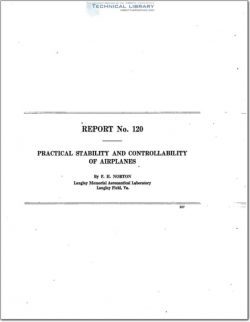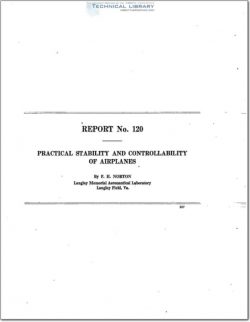naca-report-120

- Version
- 121 Downloads
- 1.23 MB File Size
- 1 File Count
- August 18, 2016 Create Date
- August 18, 2016 Last Updated
National Advisory Committee for Aeronautics, Report - Practical Stability and Controllability of Airplanes

The efiect of the characteristics of an airplane on balance, stability, and controllability,
based on free flight tests, is discussed particularly in respect to the longitudinal motion. It is
shown that the amount of longitudinal stability can be varied by changing the position of the
center _of gravity or by varying the aspect ratio of the tail plane, and that the stability for any
particular air speed can be varied by changing the camber of the tail plane. It is found that
complete longitudinal stability may be obtained even when the tail plane is at all times a lift-
ing surface. Empirical values are given for the characteristics of a new airplane for producing
any desired amount of stability and control, or to correct the faults of an airplane already
constructed.
There has been a great deal of work done on stability, but the larger part of it has been
either with models or with mathematical theory; so there is at present very little technical
data to aid the designer in predicting the exact amount of stability an airplane will have when
it is first taken into the air, or what changes are necessary to correct a particular fault. The
feel of the controls on a new airplane determines probably more than any other one thing the
test pilot’s attitude toward it, and after all the pilot is the court of last appeal on the fitness of
the airplane. There have been g'reat numbers of airplanes built which in nearly every particular
were excellent. but because of an undue force on the stick or too great an amount of stability
or instability, were condemned to be ”washouts.” 0n the other hand, the few airplanes that
do possess excellent longitudinal control in many cases are arrived at by copying some pre-
viously successful machine or are simply accidents. It is the object of this paper to bring
together what practical data there are available from free flight tests on stability for the aid
of the designer, and to indicate in what direction future research should be guided in order to
solve some of the many existing problems.
| File | Action |
|---|---|
| naca-report-120 Practical Stability and Controllability of Airplanes.pdf | Download |

Comment On This Post